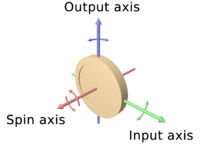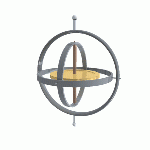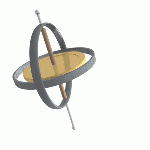Difference between revisions of "Gyroscope" - New World Encyclopedia
(added credit and category tags, deleted foreign language links) |
|||
| Line 12: | Line 12: | ||
The behaviour of a gyroscope can be most easily appreciated by consideration of the front wheel of a bicycle. If the wheel is leaned away from the vertical so that the top of the wheel moves to the left, the forward rim of the wheel also turns to the left. In other words, rotation on one axis of the turning wheel produces rotation of the third axis. | The behaviour of a gyroscope can be most easily appreciated by consideration of the front wheel of a bicycle. If the wheel is leaned away from the vertical so that the top of the wheel moves to the left, the forward rim of the wheel also turns to the left. In other words, rotation on one axis of the turning wheel produces rotation of the third axis. | ||
| − | A '''gyroscope flywheel''' will roll or resist about the output axis depending upon whether the output [[gimbal]]s are of a free | + | A '''gyroscope flywheel''' will roll or resist about the output axis depending upon whether the output [[gimbal]]s are of a free or fixed configuration. Examples of some free-output-gimbal devices would be the attitude reference gyroscopes used to sense or measure the [[Flight dynamics|pitch]], [[Flight dynamics|roll]] and [[Flight dynamics|yaw]] attitude angles in a spacecraft or aircraft. |
| − | [[Image:Gyroscope wheel animation.gif|thumb|200px|right|Animation of a gyro wheel in action]] | + | [[Image:Gyroscope wheel animation.gif|thumb|200px|right|Animation of a gyro wheel in action.]] |
The center of gravity of the rotor can be in a fixed position. The rotor simultaneously spins about one axis and is capable of oscillating about the two other axes, and thus, except for its inherent resistance due to rotor spin, it is free to turn in any direction about the fixed point. Some gyroscopes have mechanical equivalents substituted for one or more of the elements, e.g., the spinning rotor may be suspended in a fluid, instead of being pivotally mounted in gimbals. A control moment gyroscope (CMG) is an example of a fixed-output-gimbal device that is used on spacecraft to hold or maintain a desired attitude angle or pointing direction using the gyroscopic resistance force. | The center of gravity of the rotor can be in a fixed position. The rotor simultaneously spins about one axis and is capable of oscillating about the two other axes, and thus, except for its inherent resistance due to rotor spin, it is free to turn in any direction about the fixed point. Some gyroscopes have mechanical equivalents substituted for one or more of the elements, e.g., the spinning rotor may be suspended in a fluid, instead of being pivotally mounted in gimbals. A control moment gyroscope (CMG) is an example of a fixed-output-gimbal device that is used on spacecraft to hold or maintain a desired attitude angle or pointing direction using the gyroscopic resistance force. | ||
Revision as of 14:17, 11 May 2007
- For other uses, see Gyroscope (disambiguation).
A gyroscope is a device for measuring or maintaining orientation, based on the principle of conservation of angular momentum. The essence of the device is a spinning wheel on an axle. The device, once spinning, tends to resist changes to its orientation due to the angular momentum of the wheel. In physics this phenomenon is also known as gyroscopic inertia or rigidity in space.
Description and diagram
Within mechanical combinations or devices constituting portions of machines, a conventional gyroscope is a mechanism comprising a rotor journaled to spin about one axis, the journals of the rotor being mounted in an inner gimbal or ring, the inner gimbal being journaled for oscillation in an outer gimbal which in turn is journaled for oscillation relative to a support. The outer gimbal or ring is mounted so as to pivot about an axis in its own plane determined by the support. The outer gimbal possesses one degree of rotational freedom and its axis possesses none. The inner gimbal is mounted in the outer gimbal so as to pivot about an axis in its own plane, which axis is always perpendicular to the pivotal axis of the outer gimbal.
The axle of the spinning wheel defines the spin axis. The inner gimbal possesses two degrees of rotational freedom and its axis possesses one. The rotor is journaled to spin about an axis which is always perpendicular to the axis of the inner gimbal. Hence the rotor possesses three degrees of rotational freedom and its axis possesses two. The wheel responds to a force applied about the input axis by a reaction force about the output axis. The 3 axes are perpendicular, and this cross-axis response is the simple essence of the gyroscopic effect.
The behaviour of a gyroscope can be most easily appreciated by consideration of the front wheel of a bicycle. If the wheel is leaned away from the vertical so that the top of the wheel moves to the left, the forward rim of the wheel also turns to the left. In other words, rotation on one axis of the turning wheel produces rotation of the third axis.
A gyroscope flywheel will roll or resist about the output axis depending upon whether the output gimbals are of a free or fixed configuration. Examples of some free-output-gimbal devices would be the attitude reference gyroscopes used to sense or measure the pitch, roll and yaw attitude angles in a spacecraft or aircraft.
The center of gravity of the rotor can be in a fixed position. The rotor simultaneously spins about one axis and is capable of oscillating about the two other axes, and thus, except for its inherent resistance due to rotor spin, it is free to turn in any direction about the fixed point. Some gyroscopes have mechanical equivalents substituted for one or more of the elements, e.g., the spinning rotor may be suspended in a fluid, instead of being pivotally mounted in gimbals. A control moment gyroscope (CMG) is an example of a fixed-output-gimbal device that is used on spacecraft to hold or maintain a desired attitude angle or pointing direction using the gyroscopic resistance force.
In some special cases, the outer gimbal (or its equivalent) may be omitted so that the rotor has only two degrees of freedom. In other cases, the center of gravity of the rotor may be offset from the axis of oscillation, and thus the center of gravity of the rotor and the center of suspension of the rotor may not coincide.
History
The gyroscope effect was discovered in 1817 by Johann Bohnenberger; the gyroscope was invented, and the effect named after it, in 1852 by Léon Foucault for an experiment involving the rotation of the Earth. Foucault's experiment to see (skopeein, to see) the Earth's rotation (gyros, circle or rotation) was unsuccessful due to friction, which effectively limited each trial to 8 to 10 minutes, too short a time to observe significant movement. In the 1860s, however, electric motors made the concept feasible, leading to the first prototype gyrocompasses; the first functional marine gyrocompass was developed between 1905 and 1908 by German inventor Hermann Anschütz-Kaempfe. The American Elmer Sperry followed with his own design in 1910, and other nations soon realized the military importance of the invention—in an age in which naval might was the most significant measure of military power—and created their own gyroscope industries. The Sperry Gyroscope Company quickly expanded to provide aircraft and naval stabilizers as well, and other gyroscope developers followed suit.[1]
In the first several decades of the 20th century, other inventors attempted (unsuccessfully) to use gyroscopes as the basis for early black box navigational systems by creating a stable platform from which accurate acceleration measurements could be performed (in order to bypass the need for star sightings to calculate position). Similar principles were later employed in the development of inertial guidance systems for ballistic missiles.[2]
Properties
A gyroscope exhibits a number of behaviours including precession and nutation. Gyroscopes can be used to construct gyrocompasses which complement or replace magnetic compasses (in ships, aircraft and spacecraft, vehicles in general), to assist in stability (bicycle, Hubble Space Telescope, ships, vehicles in general) or be used as part of an Inertial guidance system. Gyroscopic effects are used in toys like yo-yos and Powerballs. Many other rotating devices, such as flywheels, behave gyroscopically although the gyroscopic effect is not used.
The fundamental equation describing the behavior of the gyroscope is:
where the vectors and are, respectively, the torque on the gyroscope and its angular momentum, the scalar is its moment of inertia, the vector is its angular velocity, and the vector is its angular acceleration.
It follows from this that a torque applied perpendicular to the axis of rotation, and therefore perpendicular to , results in a motion perpendicular to both and . This motion is called precession. The angular velocity of precession is given by the cross product:
Precession can be demonstrated by placing a spinning gyroscope with its axis horizontal and supported loosely (frictionless toward precession) at one end. Instead of falling, as might be expected, the gyroscope appears to defy gravity by remaining with its axis horizontal, when the other end of the axis is left unsupported and the free end of the axis slowly describes a circle in a horizontal plane, the resulting precession turning. This effect is explained by the above equations. The torque on the gyroscope is supplied by a couple of forces: gravity acting downwards on the device's centre of mass, and an equal force acting upwards to support one end of the device. The motion resulting from this torque is not downwards, as might be intuitively expected, causing the device to fall, but perpendicular to both the gravitational torque (downwards) and the axis of rotation (outwards from the point of support), i.e. in a forward horizontal direction, causing the device to rotate slowly about the supporting point.
As the second equation shows, under a constant torque due to gravity or not, the gyroscope's speed of precession is inversely proportional to its angular momentum. This means that, for instance, if friction causes the gyroscope's spin to slow down, the rate of precession increases. This continues until the device is unable to rotate fast enough to support its own weight, when it stops precessing and falls off its support, mostly because friction against precession cause another precession that goes to cause the fall.
By convention, these three vectors, torque, spin, and precession, are all oriented with respect to each other according to the right-hand rule.
To easily ascertain the direction of gyro effect, simply remember that a rolling wheel tends, when entering a corner, to turn over to the inside.
Gyrostat
A gyrostat is a variant of the gyroscope. The first gyrostat was designed by Lord Kelvin to illustrate the more complicated state of motion of a spinning body when free to wander about on a horizontal plane, like a top spun on the pavement, or a hoop or bicycle on the road. It consists essentially of a massive flywheel concealed in a solid casing. Its behaviour on a table, or with various modes of suspension or support, serves to illustrate the curious reversal of the ordinary laws of static equilibrium due to the gyrostatic behaviour of the interior invisible flywheel when rotated rapidly.
Small manually-spun gyrostats are sold as childrens' toys under the brand name Wizzer.
Gyroscopes in Fiction
- In the film Contact, The Machine closely resembles a gyroscope
- Thir13en Ghosts
U.S. Patents
In the USPTO classification scheme, the generic locus for gyroscope patents is Class 74, Machine element or mechanism, and Subclass 5R. Every rotating body has gyroscopic action, but such devices are not included unless at least one axis of oscillation is present. The combinations of gyroscopes with other devices are placed in subclass 5.22.
- Numbers
- U.S. Patent 839,161 (PDF), "Steering apparatus for automobile torpedoes", .
- U.S. Patent 795,045 (PDF), "Gyroscopic control apparatus", .
- U.S. Patent 785,587 (PDF), "Mechanical speed governor".
- U.S. Patent 785,425 (PDF), "Steering mechanism for torpedoes".
- U.S. Patent 751,888 (PDF), "Governing mechanism for turbines".
- U.S. Patent 738,823 (PDF), "Electrical apparatus".
- U.S. Patent 730,613 (PDF), "Meter".
- U.S. Patent 662,484 (PDF), "Electric top for gyroscopes".
- U.S. Patent 648,878 (PDF), "Gyroscope for torpedo steering mechanism".
- U.S. Patent 642,704 (PDF), "Roller bearing car wheel".
- U.S. Patent 484,960 (PDF), "Gyroscopic top".
- U.S. Patent 461,948 (PDF), "Gyroscope or revolving toy".
- U.S. Patent 365,530 (PDF), "Lumber cart".
- U.S. Patent 312,692 (PDF), "Vehicle wheel".
- U.S. Patent 220,867 (PDF), "Engine-governor and speed-regulator".
- U.S. Patent 162,446 (PDF), "Governor for steam engine".
- U.S. Patent 34,298 (PDF), "Levelling instrument".
- Reissued
- U.S. Patent RE024880 (PDF), "Rate Gyroscope with torsional suspension"
See also
- Gyrocompass
- Momentum wheel
- Fibre optic gyroscope
- Ring laser gyroscope
- Vibrating structure gyroscope
- Gimbal
- Gimbal lock
- Quantum gyroscope
- Gyrocar
- Top
- Aerotrim
- NSDPowerball
- Dynabee
- Eric Laithwaite
- Precession
- Gyro Monorail
- Control Moment Gyroscope
- Segway
ReferencesISBN links support NWE through referral fees
- ↑ MacKenzie, Donald. Inventing Accuracy: A Historical Sociology of Nuclear Missile Guidance. Cambridge: MIT Press, 1990. pp 31-40. ISBN 0-262-13258-3
- ↑ MacKenzie, pp 40-42.
External articles and further readings
- Books
- Felix Klein and Arnold Sommerfeld, "Über die Theorie des Kreisels" (Tr., About the theory of the gyroscope). Leipzig, Berlin, B.G. Teubner, 1898-1914. 4 v. illus. 25 cm.
- Websites
- The Precession and Nutation of a Gyroscope
- Everything you needed to know about gyroscopes
- Videos of gyroscopes working
- Project in which gyroscopes are used to drive a robotic arm
Credits
New World Encyclopedia writers and editors rewrote and completed the Wikipedia article in accordance with New World Encyclopedia standards. This article abides by terms of the Creative Commons CC-by-sa 3.0 License (CC-by-sa), which may be used and disseminated with proper attribution. Credit is due under the terms of this license that can reference both the New World Encyclopedia contributors and the selfless volunteer contributors of the Wikimedia Foundation. To cite this article click here for a list of acceptable citing formats.The history of earlier contributions by wikipedians is accessible to researchers here:
The history of this article since it was imported to New World Encyclopedia:
Note: Some restrictions may apply to use of individual images which are separately licensed.











